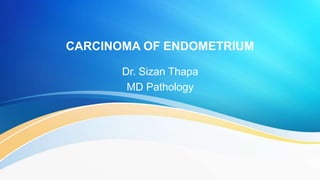CARCINOMA OF ENDOMETRIUM (endometrioiod and serous carcinoma of uterine corpus).pptx
- 1. CARCINOMA OF ENDOMETRIUM Dr. Sizan Thapa MD Pathology
- 2. Lesson Plan ŌĆó Introduction ŌĆó Types ŌĆó Defination ŌĆó Epidemiology ŌĆó Etiopathogenesis ŌĆó Morphology ŌĆó Clinical Features
- 3. ŌĆó Most common invasive carcinoma of the female genital tract - esp advanced world ŌĆó Increase in incidence due to early detection and treatment of Cervical carcinoma ŌĆó Types ŌĆō 2 main types along with other less frequent types
- 4. Types ŌĆó Endometrioid carcinoma ŌĆó Serous carcinoma ŌĆó Clear cell carcinoma ŌĆó Mixed Mullerian tumor (Carcinosarcoma)
- 5. ENDOMETRIAL ENDOMETRIOID CARCINOMA DEFINATION ŌĆó Malignant epithelial neoplasm displaying varying proportions of glandular, papillary and solid architecture, with the neoplastic cells showing endometrioid differentiation.
- 6. EPIDEMIOLOGY ŌĆó Seventh most common tumor in females ŌĆó Second most common tumor of female genital tracts ŌĆó Incidence is higher in countries with high HDI than those with low HDI ŌĆó Varies from 1 - 25/ 100000 person ŌĆó Age: Perimenopausal women ŌĆó Percursor lesions ŌĆō Endometrial hyperplasia with atypia
- 7. PATHOGENESIS ŌĆó Estrogen excess in the setting of endometrial hyperplasia in perimenopausal women ŌĆó Associated with conditions leading to excess estrogen ŌĆō Obesity ŌĆō Estrogen secreting ovarian tumors ŌĆō Exogenous estrogen
- 8. ŌĆó Mutations in mismatch repair genes and PTEN (tumor supressor genes ŌĆō Early events in the development ŌĆō Mostly somatic mutations ŌĆō Women with germline mutation in PTEN (Cowden syndrome) and mismatch repair genes (Lynch syndrome) are at high risk ŌĆó TP53 mutations are seen but rare and late event ŌĆó Mutation --> increased signalling through PI3K/AKT pathway.
- 9. ŌĆó Increased expression of estrogen receptor dependent target genes in endometrial cells. ŌĆó Leads to tumor development and progression ŌĆó Mismatch repair genes mutations lead to rapid accumulation of mutations that may alter the cancer genes --> Derive tumor development
- 10. MORPHOLOGY ŌĆó Gross features ŌĆō Exophytic or diffusely infiltrative ŌĆō Varying degree of hemorrhage and necrosis ŌĆō Some may arise in lower uterine segment ŌĆō Spread by myometrial invasion then direct extension into adjacent structures ŌĆō Metastasis to regional lymph nodes and distant organs occurs late
- 11. ŌĆó Microscopic features ŌĆō 3 grades based on differentiation ŌĆō Mostly well differentiated ŌĆō Villoglandular architecture resembling proliferative endometrium ŌĆō Columnar cells with pseudostratified nuclei ŌĆō Nuclear atypia: mild to moderate ŌĆō Nucleoli: inconspicious ŌĆō Cytplasm: eosinophilic and granular
- 13. ŌĆó Grading ŌĆō FIGO system ŌĆō Grade I : < 5% solid part ŌĆō Grade II : 6-50 % solid part ŌĆō Grade III :> 50% solid part
- 14. ŌĆó CLINICAL FEATURES ŌĆō Abnormal uterine bleeding ŌĆō Postmenopausal bleeding ŌĆō Advanced disease : abdominal symptoms resembling those of Ovarian carcinoma.
- 15. SEROUS CARCINOMA OF ENDOMETRIUM DEFINATION ŌĆó Malignant carcinoma with diffuse, marked nuclear pleomorphism, typically exhibiting papillary and/or glandular growth patterns
- 16. EPIDEMIOLOGY ŌĆó 10% of all endometrial carcinomas ŌĆó Higher in black women ŌĆó High risk: multiparity, history of breast cancer, tamoxifen use, pelvic irradiation ŌĆó Age : elderly post menopausal women
- 17. PATHOGENESIS ŌĆó Arise in a setting of atrophic endometrium or endometrial polyp ŌĆó Precursor lesion : Serous endometrial intraepithelial carcinoma (SEIC) ŌĆó Majority exhibit TP53 mutation-->Altered p53 function
- 18. MORPHOLOGY ŌĆó Gross Features ŌĆō Variable ŌĆō May look overtly invasive into myometrium ŌĆō Polyp may be present
- 19. ŌĆó Microscopic Features ŌĆō Complex papillary and/or glandular architecture ŌĆō Glands are typically elongated, irregular with slit like lumen ŌĆō High grade cytology with marked nuclear pleomorphism, macronucleoli and mitosis ŌĆō Multinucleated tumor giant cells and psammomatous calcifications may be seen ŌĆō IHC : diffuse staining for p53
- 22. ŌĆó CLINICAL FEATURES ŌĆō Presents with post menopausal bleeding ŌĆō May present with features of lymph node metastasis or distant metastasis to other organs
- 23. Thank you






















